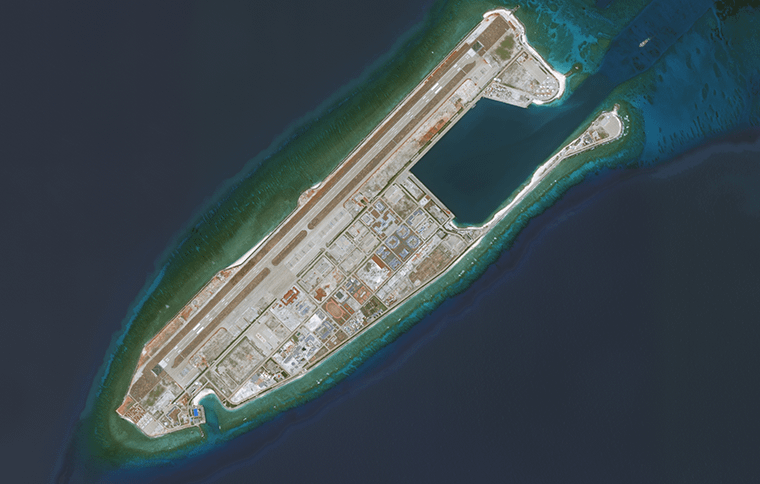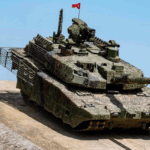Summary by Geopolist | Istanbul Center for Geopolitics:
The article from IRIS explores the U.S.’s strategic dilemma in countering China’s “grey zone” tactics in the South China Sea. China uses its maritime militia and coast guard, engaging in non-military actions like harassment and presence operations, to assert control without provoking outright war. This strategy, aimed at gradual territorial gains and avoiding major conflicts, challenges traditional U.S. military responses. The article highlights the complexity of developing a coherent strategy to address these subtle, persistent provocations by China.
For more details, you can read the full article here ↓.
‘There are two ways to fight American armies – asymmetric and stupid’[1]is how US General H. R. McMaster describes the choice available to any actor seeking to oppose the United States. Unsurprisingly, the People’s Republic of China (PRC) has opted for asymmetry in order to secure de facto control over a large proportion of the atolls, islands and reefs in the China Sea and their surrounding waters, while making it impossible for any serious response to be forthcoming, either from the injured coastal nations or from Washington. It has to be said, then, that it is not the powerful first-rank ships of the People’s Liberation Army Navy (PLAN) that have enabled the PRC to make substantial territorial gains in the South China Sea and that carry out day-to-day sovereignty missions over the waters that Beijing considers to be its rightful property. To achieve this, Beijing is resorting to ‘Small Stick Diplomacy’, as James R. Holmes calls China’s strategy, i.e. the deployment of the People’s Armed Forces Maritime Militia (PAFMM) and the China Coast Guard (CCG), using vessels with much smaller capacity and tonnage than those of the PLAN, but perfectly suited to harassment[2], ISR (intelligence gathering, surveillance and reconnaissance) and presence missions. It is these forces that are on the front line and intervene on a daily basis against fishermen and coastguards from nations bordering the China Sea who oppose Beijing’s claims.
In order to achieve its aims, the PRC places itself in ‘the space between war and peace’, to use Nadia Schadlow’s phrase. The PAFMM and the GCC do not hesitate to use tactics involving the use of unarmed force, deliberately ramming the ships of third nations and using high-pressure water cannons to flood engines and destroy navigation equipment. These actions cannot, of course, be described as peaceful, but neither can the situation in the China Sea be described as an armed conflict. They must therefore be associated with a new form of conflict: the grey zone.
The grey zone: a new form of conflict
To date, there is no unanimously accepted definition of the grey zone, and the difficulty of arriving at one will be discussed below. Nevertheless, the most concise definition is that proposed by Michael Mazarr, who characterises a grey zone conflict in terms of the following four markers[3]:
-
- The conflict is aimed at pursuing political objectives through combined operations campaigns
-
- The conflict is marked by the predominant use of non-military and non-kinetic means.
-
- The parties to the conflict endeavour to remain below escalation thresholds and not to cross red lines in order to avoid a conventional direct conflict.
-
- The objectives of the conflict are achieved gradually rather than by seeking decisive results in a given period.
However, it would be misleading to reduce the actions that make up the PRC’s grey zone campaigns to their purely kinetic aspects, as the vast majority of grey zone missions are presence operations carried out by second-rank PAFMM and CCG units and vessels from the Chinese fishing fleet at all the key points in the waters claimed by Beijing. Furthermore, the study of grey zone campaigns cannot be reduced to the maritime component alone. Indeed, it is imperative to take the measure of the ‘Three Wars’ to use the Chinese formula. This concept covers psychological warfare (border military manoeuvres, cultural or economic diplomacy, etc.), which aims to reduce the cost/benefit ratio of a forceful response in the eyes of the aggressor, encouraging it to choose not to react in any significant way. In this respect, the hybrid nature of the PAFMM, an organisation that is both civilian and military, is perfectly suited: ‘By putting on military uniforms, [PAFMM members] become soldiers; by taking off the uniforms, they become [ordinary] citizens’. Finally, the last component of this triptych is the legal war through which the PRC constantly seeks to endow its de facto control of the China Sea with legal legitimacy by putting forward historical elements or interpretations in its favour, the best known of these attempts being that of the nine-dash line and the ‘constitution’ of historical rights in order to legitimise its territorial claims.
It is also important to understand the gradual nature of China’s grey zone campaigns and the role played by escalation control. Indeed, as Peter A. Dutton writes, ‘instead of adding escalation rungs at the top of the ladder, [the PRC] is adding rungs at the bottom’[4]. So rather than taking over all the areas it claims in one fell swoop, the PRC is applying a ‘salami tactic’ whereby it is reducing these areas into very small gains, which it is taking over as it goes along, over a relatively long period of time. Andrew Scobell even describes this approach as a ‘slow-intensity conflict’. The dilemma facing the victims of the Chinese countryside can therefore be summed up as follows: « Are we prepared to risk an armed escalation against the regional hyperpower, which is also a very important trading partner, with no assurance of being followed by our allies, all for an uninhabited atoll occupied by unarmed fishing vessels whose direct affiliation with the Chinese state we cannot prove, and which have not used armed force?
The actions of the People’s Republic of China in the grey zone and the dilemma of the US response
However, before even considering the development of a strategy to respond to China’s actions, it is necessary to resolve one of the most thorny problems: how to qualify these actions? As previously stated, the grey zone is neither peace nor war, so what is it? This is a major stumbling block for all states facing the grey zone, and for the United States in particular. If we confine ourselves to studying the current debate, it is clear that one thinker is regularly invoked to describe China’s actions: David Galula, the ‘Clausewitz of counter-insurgency’. Based on the occasional similarities between his work and Chinese actions, the observers who refer to him describe the Chinese mode of action as a ‘maritime insurrection’ which logically calls for a counter-insurgency response. However, this biased reading implies major misunderstandings of Galula’s work, the main ones being that insurrection is purely intra-state, articulated around an internal ‘problem’ whose resolution serves as the insurgent’s cause, and finally, insurrection is a conflict in which the use of lethal armed force is central. So it quickly becomes clear that applying a counter-insurgency logic to a power with conventional military superiority in the China Sea can quickly lead to an escalation scenario that neither the PRC nor the United States want, although it should be noted that the proponents of maritime counter-insurgency are in fact more measured and do not push their logic to the extreme. However, this point should not obscure the interest of the US strategic debate. Indeed, leading authors such as Michael Mazarr, Hal Brands and Robert Haddick have carried out major research which has led to the emergence, if not of an absolute and unanimously accepted concept, at least of the main characteristics specific to the grey zone, fully justifying the unique nature of this mode of conflict and consequently the need to devise a strategy in its own right to respond to the PRC. However, the most revealing is undoubtedly the 2022 National Defense Strategy of the United States. It states that the United States must confront ‘competitor doctrines that pose new threats to US territory and strategic stability’ that represent ‘an escalation of coercive activities by competitors in the grey zone’. Grey zone methods are described as ‘coercive approaches that may fall below the perceived threshold for US military action and that impact the remit of different parts of the US government’. It is particularly interesting to see that the Department of Defense (DoD) recognises that the military tools designed for conventional warfare are not the most suitable for countering the grey zone: ‘traditional military tools may not always be the most appropriate responses’. Finally, the DoD recognises that there is a real challenge in campaigning against grey zone actors and that the best way to do this is to develop a global approach including combined operations between the United States and its allies and the various US agencies.
Assessment and prospects for the People’s Republic of China’s strategy in the grey zone
First and foremost, the extent of China’s gains needs to be put into perspective, since they have been achieved through de facto control based on a permanent maritime presence that contravenes international law. They can only be preserved at the cost of maintaining GCC and PAFMM contingents in the main grey zone theatres, otherwise they will be immediately lost if they withdraw. This raises the question of how to characterise victory in the grey zone, as Mazarr writes: ‘for China, the day when all the other littoral states accept Beijing’s claims to key elements of the South China Sea will be a clear signal of victory. But that day will never come ». Worse still, the PRC is now seeing the emergence of powers not bordering the South China Sea, alongside the Philippines in particular. Canada, Australia, Japan, India and the United States have announced their intention to conduct joint patrols with Manila to combat the PRC’s grey zone campaigns, or have already done so. Beijing may also have lost far more in the long term than it ultimately gained, with its image in the China Sea permanently ruined ‘as the region now sees China as an imminent threat’[5] and the exploitation of fisheries and hydrocarbon resources in occupied areas proving costly because of the constant protection it requires. But of all the risks posed by the grey zone, the most dangerous of all is that the escalation that Beijing has managed to avoid so far will one day materialise, with global repercussions because, to quote Mazarr: ‘in the long term, an accumulation of aggressive postures will provoke reactions, regardless of whether a major red line is crossed’.
__________
[1] Lt. Gen. H.R. McMaster, Ph.D., U.S. Army, ‘Continuity and Change: The Army Operating Concept and Clear Thinking About Future War’, Military Review, March/April 2015: 16.
[2] Hunter Stires, ‘The Maritime Counterinsurgency Project begins’, Proceedings, No. 433 (July 2022): 32-33.
[3] Michael Mazarr, Mastering the Gray Zone: Understanding a Changing Era of Conflict, (US Army War College, 2015): 158.
[4] Andrew Erickson, Ryan Martinson, China’s Maritime Gray Zone operations, (Naval Institute Press, 2019): 324.
[5] Michael Mazarr, Mastering the Gray Zone: Understanding a Changing Era of Conflict, (US Army War College, 2015): 158.
By Julien Chevallier, IRIS Sup’ graduate in Defence, Security and Crisis Management
Source: French Institute for International and Strategic Affairs (IRIS)







